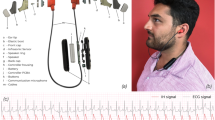Abstract
Dynamic earphones/headphones and microphones can detect sounds below the human audible frequency. Based on this principle, we propose a new method of human pulse measurement using consumer earphones and headphones. It is a simple signal separation-based method utilizing pressure changes inside the ear canal and around the tragus caused by heartbeats. As a result of feasibility evaluation using an electrocardiogram, the pulses derived by the earphone/headphone were highly feasible in terms of accurate peak-to-peak determination. Furthermore, we estimated the frequency characteristics of the audio devices at the frequency of interest, the center frequency of the heart rate (around 1.4 Hz), which enables us to reproduce the original, non-distorted pulse waveform. Although this is an entirely different methodology from photoplethysmography, it is promising because heart rate can be measured while listening to music.







Similar content being viewed by others
Data availability
The data supporting this study′s findings are available from the corresponding author, S.N., upon reasonable request.
References
World Health Organization, The top 10 causes of death, “https://www.who.int/news-room/fact-sheets/detail/the-top-10-causes-of-death Accessed 12 June 2023.
Ministry of Health, Labour and Welfare of Japan, Summary report of annual vital statistics of Japan (final data), https://www.mhlw.go.jp/english/database/db-hw/populate/dl/E03.pdf Accessed 12 June 2023.
Rippe JM (2008) Lifestyle medicine: the health promoting power of daily habits and practices. Am J Lifestyle Med 12(6):499–512
Fitbit Website, https://www.fitbit.com/global/us/home Accessed 12 June 2023
Gorny AW, Liew SJ, Tan CS, Müller-Riemenschneider F (2017) Fitbit charge HR wireless heart rate monitor: validation study conducted under free-living conditions. JMIR Mhealth Uhealth 5(10):157
Benedetto S, Caldato C, Bazzan E, Greenwood DC, Pensabene V, Actis P (2018) Assessment of the Fitbit charge 2 for monitoring heart rate. PLoS ONE 13(2):e0192691
Benedetti D, Olcese U, Frumento P, Bazzani A, Bruno S, d’Ascanio P, Maestri M, Bonanni E, Faraguna U (2021) Heart rate detection by Fitbit ChargeHR™: a validation study versus portable polysomnography. J Sleep Res 30(6):e13346
Shimmer3 GSR+ Website, https://shimmersensing.com/product/shimmer3-gsr-unit/ Accessed 12 June 2023
NUL-217 Website, https://neulog.com/gsr/ Accessed 12 June 2023
Lubitz SA, Faranesh AZ, Selvaggi C, Atlas SJ, McManus DD, Singer DE, Pagoto S, McConnell MV, Pantelopoulos A, Foulkes AS (2022) Detection of atrial fibrillation in a large population using wearable devices: the Fitbit heart study. Circulation 146(19):1415–1424
Jiang F, Kobayashi T, Ichihashi T, Ito K, Nomura S (2019) The effect of citrus ginger aroma on heart rate and salivary cortisol level during sleep at home. IEEJ Trans Electr Electron Eng 14(4):623–629
Amazfit PowerBuds Pro Website, https://www.amazfit.jp/products/amazfit-powerbuds-pro Accessed 12 June 2023
Etiwy M, Akhrass Z, Gillinov L, Alashi A, Wang R, Blackburn G, Gillinov SM, Phelan D, Gillinov AM, Houghtaling PL, Javadikasgari H, Desai MY (2019) Accuracy of wearable heart rate monitors in cardiac rehabilitation. Cardiovasc Diagn Ther 9(3):262–271
Boudreaux BD, Hebert EP, Hollander DB, Williams BM, Cormier CL, Naquin MR, Gillan WW, Gusew EE, Kraemer RR (2018) Validity of wearable activity monitors during cycling and resistance exercise. Med Sci Sports Exerc 50(3):624–633
Navalta JW, Montes J, Bodell NG, Salatto RW, Manning JW, DeBeliso M (2020) Concurrent heart rate validity of wearable technology devices during trail running. PLoS ONE 15(8):e0238569
Garmin Website, “https://www.garmin.com/en-US/” Accessed 12 June 2023
Galaxy Watch5 Website, https://www.samsung.com/us/watches/galaxy-watch5/ Accessed 12 June 2023
Acharya UR, Joseph KP, Kannathal N, Lim CM, Suri JS (2006) Heart rate variability: a review. Med Biol Eng Comput 44(12):1031–1051
Yasuno Y (2008) Microphones using micro electro mechanical systems. J Acoust Soc Japan 64(11):661–666
Nomura S, Hanasaka Y, Ishiguro T, Ogawa H (2011) Human pulse wave measurement by MEMS electret condenser microphone. IEEJ Trans Electron Inf Syst 131(9):1553–1558
Sano Y, Kataoka Y, Ikuyama T, Wada M, Imano H, Kawamura K, Watanabe T, Nishida A, Osanai H (1985) Evaluation of peripheral circulation with accelerated plethysmography and its practical application. J Sci Labour 61(3):129–143
Voropai A, Sarana V (2022) A wearable heart rate monitoring system based on over-ear headphones. J Med Eng Technol 46(7):604–607
Berntson GG, Bigger JT Jr, Eckberg DL, Grossman P, Kaufmann PG, Malik M, Nagaraja HN, Porges SW, Saul JP, Stone PH, van der Molen MW (1997) Heart rate variability: origins, methods, and interpretive caveats. Psychophysiology 34(6):623–648
Wakabayashi N, Shimakawa H, Harada F (2022) Evaluation of biological signals measurable with wearable sensors for stress identification. Trans Inst Syst Control Inf Eng 35(9):217–227
Althaff Irfan CM, Nomura S, Yamagishi T, Kurosawa Y, Yajima K, Nakahira KT, Fukumura Y (2011) Utilization of bio-signals to understand the physiological states of e-learners and improve the learning contents. IEICE Trans Inf Syst 94(6):1235–1242
Author information
Authors and Affiliations
Corresponding author
Additional information
Publisher's Note
Springer Nature remains neutral with regard to jurisdictional claims in published maps and institutional affiliations.
This work was submitted and accepted for the Journal Track of the joint symposium of the 29th International Symposium on Artificial Life and Robotics, the 9th International Symposium on BioComplexity, and the 7th International Symposium on Swarm Behavior and Bio-Inspired Robotics (Beppu, Oita and Online, January 24–26, 2024).
About this article
Cite this article
Yi, X., Herath, S.S., Ogawa, H. et al. Human pulse wave detection with consumer earphones and headphones. Artif Life Robotics 29, 22–28 (2024). https://doi.org/10.1007/s10015-023-00933-4
Received:
Accepted:
Published:
Issue Date:
DOI: https://doi.org/10.1007/s10015-023-00933-4




